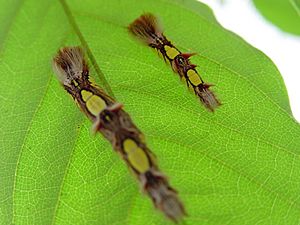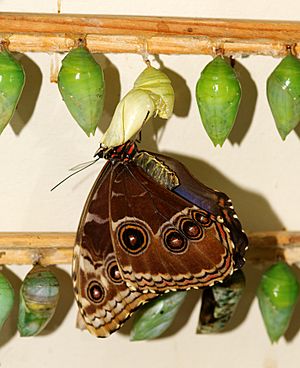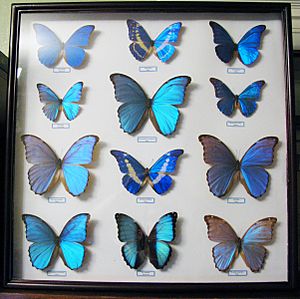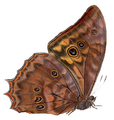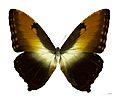Morpho facts for kids
Quick facts for kids Morpho butterflies |
|
|---|---|
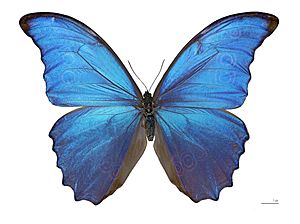 |
|
| Morpho didius – Museum specimen | |
| Scientific classification | |
| Kingdom: | |
| Phylum: | |
| Class: | |
| Order: | |
| Family: | |
| Subfamily: |
Morphinae
|
| Genus: |
Morpho
|
A Morpho is a type of butterfly. There are more than 29 different kinds, called species, and 147 smaller groups, called subspecies, in the genus Morpho.
Morpho butterflies live in warm, tropical parts of the world. You can find them mostly in South America, Mexico, and Central America. Their wings can be quite big! The smallest, M. rhodopteron, has a wingspan of about 7.5 cm (3 inches). The largest, the Sunset Morpho (M. hecuba), can have wings up to 20 cm (8 inches) wide.
Contents
What's in a Name?
The name Morpho comes from an old Greek word, "morpho." This word means "the shapely one" or "the beautiful one." It was a special name for Aphrodite, the Greek goddess of love and beauty. This name certainly fits these stunning butterflies!
Amazing Colours of Morpho Butterflies
Many Morpho butterflies are famous for their shiny, metallic blue and green colours. These bright colours are not made by pigments, like paint. Instead, they are an example of something called iridescence.
Iridescence happens when light bounces off tiny, microscopic scales on the butterfly's wings. These scales are arranged in a special way, like tiny layers. When light hits them, it splits and reflects in different directions, making the wings shimmer and change colour as you look at them from different angles. It's like looking at a soap bubble or an oil slick!
Where Morpho Butterflies Live
Morpho butterflies mostly live in the thick, primary forests of the Amazon and Atlantic regions. These are very old and untouched forests.
However, they can also live and have their babies in other types of wooded areas. For example, some Morphos live in the dry forests of Nicaragua or in forests that have grown back after being cut down.
How Morpho Butterflies Fly
Morphos are very strong fliers. They can be found from sea level up to about 1400 meters high. They are also diurnal, which means they are active during the day.
Male Morpho butterflies often spend their mornings flying along forest streams and rivers. They are quite territorial, meaning they protect their space. If another male Morpho comes into their area, they will chase it away! Outside of mating season, Morphos usually live by themselves.
How Morpho Butterflies Protect Themselves
Adult Morpho butterflies are tasty to birds, but they are very hard to catch because they fly so fast and strongly. Birds often have a tough time grabbing them.
The bright blue colour of most Morpho species might be a way to protect themselves. It could be a type of "Müllerian mimicry," where the colour warns predators. Or, it might be "pursuit aposematism." This means the bright colour tells a bird, "Don't bother trying to catch me, you'll just waste your energy!" The bird learns that the blue colour means the butterfly is too fast to catch.
The Life Cycle of a Morpho Butterfly
The whole life cycle of a Morpho butterfly, from when it's an egg until it dies, takes about 115 days.
Even though adult Morphos can be eaten by predators, their young, called larvae or caterpillars, are not. Their hairs can be irritating if touched. If a caterpillar feels threatened, it can release a bad-smelling fluid that smells like old, rotten butter. This strong smell helps to keep predators away.
A Morpho caterpillar will shed its skin five times as it grows. After this, it changes into a pupa, also known as a chrysalis. The chrysalis is round and can be pale green or jade green. If you touch it, it makes a loud, high-pitched sound that you can't always hear, but it helps scare away predators. The chrysalis hangs from a stem or a leaf of the plant the caterpillar was eating.
Morpho Butterflies and Collectors
Morpho butterflies have always been very popular with collectors because of their beauty. They were often quite expensive. In the past, these butterflies were found in special collections called "cabinets of curiosities" or royal natural history collections. Famous people like Tsar Peter the Great of Russia and Empress Maria Theresa of Austria had them.
One famous person who studied and drew butterflies, including Morphos, was Maria Sibylla Merian. She wasn't wealthy, but her work was very important.
People living along the Rio Negro in Brazil used to catch blue Morpho butterflies (like M. menelaus) in a clever way. They knew these butterflies were territorial. So, they would put bright blue fake butterflies in clearings to trick the real ones into flying closer. The wings from the collected butterflies were then used to decorate special masks for ceremonies.
Adult Morpho butterflies like to feed on the juices of fermenting fruit. People can also use this to attract them. When Morphos are feeding, they often fly in a wobbly way, which makes them easier to catch.
Images for kids
-
Iridescent colors of Morpho butterflies are caused by the specific nanostructures on their wings (SEM image at the bottom).
-
Atlantic Forest in Paraguay
-
Maria Sibylla Merian Metamorphosis Insectorum Surinamensium 1705
-
George Shaw and Frederick Polydore NodderThe Naturalist's Miscellany 1789–1813
-
Frederick DuCane Godman and Osbert Salvin Biologia Centrali-Americana 1879–1915
See also
 In Spanish: Morpho para niños
In Spanish: Morpho para niños
- List of tropical and subtropical moist broadleaf forests ecoregions (Neotropical)
- Tropical Andes
- Arhopala


